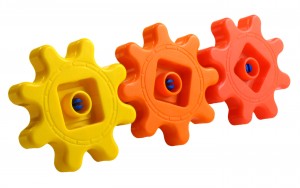SEO Marketing Part 3: Navigation, Linking

This is our third and final post in the SEO Marketing Tips series (but keep in mind not the final post with SEO tips). We are going to discuss the parts of SEO usually directly related to the design of a website itself.
The first part navigation, is the part of your site that directs visitors around your site. Think of it like traffic signs. Usually the main navigation is located horizontally, at the top of your site. It can also be vertical, and doesn’t necessarily need to be at the top. In this menu, you want to have things such as most important links, categories, etc.
The secondary navigation is usually located in the sidebar of the website, and contains less important links, such as: secondary links, subcategories, etc.
When creating navigation, it is good to ensure your navigation meets the following criteria:
- People can enter a site through any page, not just the homepage. This means that every page must have a universal, functional navigation. They should be able to reach the homepage from any page within the site.
- Ensure your navigation is visible. You want to put the navigation in a place that is visible, and not hard to find, yet does not overpower the user or draw their eyes away from content. A great example is Google’s Navigation. (google.com). It is extremely simple, yet very visible without taking your attention.
- Choose understandable link titles. You must make sure that your link titles are relevant to the page they link to, and that they do not confuse the user. For example if you have a contact form on your site, a good link title is “contact us” instead of “Email Form”.
- Keep the number of links manageable. Ensure that you only have roughly 3-8 links on your main navigation so that you don’t overwhelm your visitors. The more links you have, the harder it will be to find an individual link, and therefore potential conversions may leave your site.
- Keep in mind the “Less Clicks the Better” concept. When designing your navigation, keep in mind that the more clicks it takes for a user to get where they want to be, the more likely they are to leave before they get there.
- Make the primary navigation stand out by using graphics or different links style.
- If using graphics or javascript links, a text alternative should be available. Some people might have the graphics turned off or javascript disabled when browsing the Internet. In such cases an alternate option should be available. To achieve this, a text menu and the bottom of the page could be included.
Linking
In the eyes of a search engine, if a web site is prepared to link to another site, it’s a sign that the web site is credible. What’s more, the text used for the link has to have some relevance: if a popular horse stud site links to your horse blankets site using the anchor text, “great horse blankets, ” then your site gains popularity and some added relevance for that keyword. The more incoming links you have pointing to your web site, the greater your overall site ranking will be.
These days, some links are more equal than others. In the case of Google, an inbound link from a high-ranking web site will have more significance than many links from low-ranking web sites. The number of links on the page, as well as where the link is in the context of the page’s copy, can also influence a search engine’s ranking of your site.
Linkbait
Creative, interesting content can be an invaluable source of generating inbound links. The most common approach is to produce linkbait: content that’s interesting, useful, controversial, or funny. It can be anything that really grabs readers’ attention and encourages them to post a link on their blogs, email it to friends, or share it on a social network. As well as being interesting or fun, a successful linkbait campaign can create numerous incoming links to your site and raise your profile.
A great example of creative link building is SlideShare, a site for uploading and sharing slide presentations. A slideshow can be quickly translated into a widget that can be embedded and used on a third-party web site. Each time a user creates a SlideShare slide show and places it on their web site, a link is generated back to SlideShare. The more people that use the service, the more links they generate.
Free tools such as applications that can be embedded like this are often more beneficial in the long term than even the most controversial one-off linkbait content.
Getting Incoming Links
So what are the best links you can possibly hope to generate for your site? Ideally they’d have your preferred keywords in the anchor text that appears in the body of the content, and be found on a web site about a similar topic to yours, but with a higher search rank. While links like these this can be bought, they can also be earned. The way to generate quality links is to create quality content that people actually want to link to. It creates an SEO benefit and generates good referral traffic from the originating web site.
Buy Links
There are plenty of opportunities to buy one-way links from web site owners. You’ll usually pay a monthly fee to the site owner in order to keep your link on the site, or pay for a one-time mention on a blog or news posting. The more popular the site, the higher the price you’ll pay for your link.
If you do choose this route, be aware that this goes against some search engines’ terms of service, and so you do run the risk (albeit low) of being excluded from the search engine altogether.
Link Exchanges
You’ll find plenty of reasons to exchange links with other sites that complement your own. For example, a horse blanket store may exchange links with a horse stud selling actual horses. The two sites are relevant to one another, without competing against each other.
Directories
Directories are sites that contain collections of links to web sites, usually organized by categories. They are an easy way to gain one-way links. Some rank sites by quality and are moderated by real humans; others will accept any old site. Getting links from directories is probably the easiest way to generate a large volume of links, however the overall value of these links can be low. Links from related web sites are much better and should remain your number one priority.
This wraps up our final post in the 3 part series. Stay tuned for more valuable help!















Leave a Reply